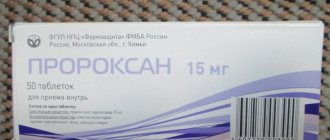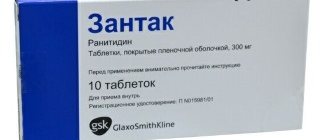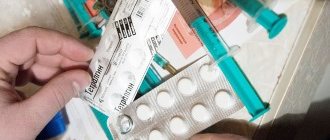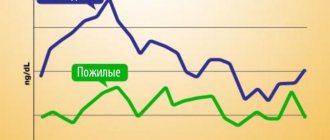Write a review
Reviews: 0
Manufacturers: Slovakofarma
Active ingredients
- Pentoxifylline
Disease class
- Not indicated. See instructions
Clinical and pharmacological group
- Not indicated. See instructions
Pharmacological action
- Vasodilator (vasodilator)
- Improves microcirculation
- Antiaggregation
Pharmacological group
- Antiplatelet agents
- Angioprotectors and microcirculation correctors
- Adenosinergic drugs
Agapurin tablets
Instructions for medical use of the drug
Indications for use
Impaired peripheral circulation due to atherosclerotic, diabetic and inflammatory processes (including intermittent claudication caused by atherosclerosis, diabetic angiopathy, obliterating endarteritis); trophic tissue disorders due to impaired arterial or venous microcirculation (varicose ulcers, gangrene, frostbite); angioneuropathy (paresthesia, acrocyanosis, Raynaud's disease); acute and chronic cerebrovascular accident of ischemic origin (including cerebral atherosclerosis); conditions after hemorrhagic or ischemic stroke; circulatory disorders in the vessels of the eye (acute and chronic circulatory failure of the retina and choroid); dysfunction of the middle ear of vascular origin, accompanied by hearing loss.
Release form
film-coated tablets 100 mg; dark glass bottle (bottle) 60, cardboard pack 1. film-coated tablets 100 mg; bottle (bottle) 60, cardboard pack 1.
Pharmacodynamics
Improves microcirculation and rheological properties of blood. The mechanism of action is associated with the inhibition of phosphodiesterase and an increase in the content of cAMP in platelets and ATP in erythrocytes with simultaneous saturation of energy potential, which in turn leads to vasodilation, a decrease in peripheral resistance, an increase in stroke and minute blood volume without a significant change in heart rate. By expanding the coronary arteries, it increases the delivery of oxygen to the myocardium (antianginal effect) and helps improve blood oxygenation. Increases the tone of the respiratory muscles (intercostal muscles and diaphragm). When administered intravenously, it leads to increased collateral circulation and an increase in the volume of blood flowing through a sectional unit. Leads to an increase in the ATP content in the brain and has a beneficial effect on the bioelectrical activity of the central nervous system. Reduces blood viscosity, increases the elasticity of the erythrocyte membrane (due to the effect on the pathologically altered deformability of erythrocytes). Improves microcirculation in areas of poor circulation. With occlusive lesions of the peripheral arteries (“intermittent” claudication), it leads to an increase in walking distance, elimination of night cramps of the calf muscles and pain at rest.
Pharmacokinetics
The drug is rapidly metabolized in the liver. During the metabolism, several active metabolites are formed, the main of which are metabolite 1 and metabolite 5. Their concentrations in the blood plasma are 5 and 8 times (respectively) higher than the concentration of the original substance. It is excreted in the form of metabolites (94%) and through the intestines (4%), up to 90% of the dose is excreted in the first 4 hours. 2% of the drug is excreted unchanged. Pentoxifylline and its metabolites do not bind to plasma proteins. In severe renal impairment, the elimination of metabolites is slowed down. If liver function is impaired, there is an increase in T1/2 and increased bioavailability.
Use during pregnancy
Contraindicated during pregnancy. Breastfeeding should be stopped during treatment.
Contraindications for use
Hypersensitivity to pentoxifylline and substances from the group of xanthine derivatives; severe coronary or cerebral atherosclerosis; acute myocardial infarction; severe heart rhythm disturbances; uncontrolled arterial hypotension; porphyria; massive bleeding; retinal hemorrhage; acute hemorrhagic stroke; pregnancy; lactation period; age under 18 years (efficacy and safety have not been established). With caution: patients with labile blood pressure, a tendency to arterial hypotension, chronic heart failure, a tendency to hemorrhage, in a condition after recent surgery, liver and/or renal failure.
Side effects
From the central nervous system: headache, dizziness, anxiety, sleep disturbances, convulsions. From the cardiovascular system: tachycardia, arrhythmia, cardialgia, rarely - progression of angina symptoms, decreased blood pressure. From the skin: facial skin flushing, flushing of the face and upper chest, swelling, increased brittleness of nails. From the digestive tract: nausea, vomiting, feeling of heaviness in the stomach, loss of appetite, intestinal atony, exacerbation of cholecystitis, cholestatic hepatitis, bleeding from the mucous membranes of the stomach and intestines. From the senses: blurred vision, scotoma. From the hemostatic system and hematopoietic organs: thrombocytopenia, leukopenia, pancytopenia, hypofibrinogenemia; bleeding from skin vessels. Allergic reactions: rarely - itching, skin hyperemia, urticaria, angioedema, anaphylactic shock. Laboratory indicators: increased activity of liver transaminases - ALT, AST, LDH and alkaline phosphatase.
Directions for use and doses
The tablets are taken after meals, without chewing and with a sufficient amount of liquid. It is recommended to take the drug at the same time of day. The dosage of the drug and the duration of the course of treatment are determined by the attending physician individually. Usually the initial dose of the drug is 200 mg 3 times a day. If hypersensitivity reactions or poor tolerability of the drug occur, the dose is reduced to 100 mg 3 times a day. If necessary, the dose of the drug can be increased by the attending physician. If long-term therapy with the drug is necessary, the initial dose is 100 mg 3 times a day. When using the drug in the form of tablets with prolonged action, the frequency of dosing of the drug can be reduced, since this dosage form provides a longer release of the active substance and, accordingly, long-term maintenance of the required plasma concentrations of pentoxifylline. The maximum daily dose of the drug is 1200 mg. In patients with impaired renal function and creatinine clearance less than 10 ml/min, the dose of the drug should be 50% of the dose recommended for patients with normal renal function.
Overdose
Symptoms: weakness, dizziness, marked decrease in blood pressure, fainting, tachycardia, drowsiness, loss of consciousness, tonic-clonic convulsions, increased nervous excitability, hyperthermia, areflexia, signs of gastrointestinal bleeding (vomiting like “coffee grounds”). Treatment: symptomatic, aimed at maintaining respiratory function and blood pressure.
Special instructions for use
Treatment should be carried out under blood pressure monitoring. In patients with chronic heart failure, circulatory compensation should be achieved. In patients with diabetes mellitus taking hypoglycemic agents, the administration of large doses can cause severe hypoglycemia (dose adjustment is required). When prescribed simultaneously with anticoagulants, it is necessary to carefully monitor the blood coagulation system. In patients who have recently undergone surgery, systematic monitoring of hemoglobin concentration and hematocrit is necessary. The administered dose should be reduced in patients with low and unstable blood pressure. In older adults, a dose reduction (reduced elimination rate) may be necessary. Smoking may reduce the therapeutic effectiveness of the drug. The compatibility of pentoxifylline solution with another infusion solution should be checked on a case-by-case basis.
Storage conditions
List B.: In a dry place, at a temperature of 10–25 °C.
Best before date
36 months
ATX classification:
C Cardiovascular system
C04 Peripheral vasodilators
C04A Peripheral vasodilators
C04AD Purines
C04AD03 Pentoxifylline
special instructions
In patients with arterial hypotension and circulatory instability, Agapurin retard can cause a sharp decrease in blood pressure and, in rare cases, symptoms of angina pectoris, so treatment must be carried out under the control of blood pressure. Agapurine retard can be used in combination with cardiac glycosides in patients with chronic heart failure in the stage of decompensation. When prescribing Agapurin retard to patients with diabetes mellitus, dose adjustment of insulin or other antidiabetic drugs is necessary, because the development of severe hypoglycemia is possible.
Similar drugs:
- Panoxen Oral tablets
- Picamilon (Picamilonum) Oral tablets
- Cavinton forte Oral tablets
- Lopirel Oral tablets
- Nemulex Gel for oral suspension
- Valusal Gel for external use
- Cardiomagnyl Oral tablets
- Rheopolyglukin Solution for infusion
- VAP 20 (Vap 20) Concentrate for the preparation of solution for infusion
- Pentilin Solution for infusion
** The Drug Directory is intended for informational purposes only. For more complete information, please refer to the manufacturer's instructions. Do not self-medicate; Before starting to use Agapurin, you should consult a doctor. EUROLAB is not responsible for the consequences caused by the use of information posted on the portal. Any information on the site does not replace medical advice and cannot serve as a guarantee of the positive effect of the drug.
Are you interested in the drug Agapurin? Do you want to know more detailed information or do you need a doctor's examination? Or do you need an inspection? You can make an appointment with a doctor - the Euro lab is always at your service! The best doctors will examine you, advise you, provide the necessary assistance and make a diagnosis. You can also call a doctor at home . Euro lab clinic is open for you around the clock.
** Attention! The information presented in this medication guide is intended for medical professionals and should not be used as a basis for self-medication. The description of the drug Agapurin is provided for informational purposes and is not intended for prescribing treatment without the participation of a doctor. Patients need to consult a specialist!
If you are interested in any other drugs and medications, their descriptions and instructions for use, information about the composition and form of release, indications for use and side effects, methods of use, prices and reviews of drugs, or you have any other questions and suggestions - write to us, we will definitely try to help you.
Contraindications
As indicated in the instructions for Agapurin, this drug should not be used:
- If you have hypersensitivity to pentoxifylline, any of the auxiliary components of the drug or other xanthine derivatives;
- Patients with acute myocardial infarction;
- With massive bleeding;
- Patients with hemorrhagic stroke;
- With hemorrhage in the retina of the eye;
- Pregnant women;
- During lactation.
Intravenous administration of Agapurin solution, except for the cases described, is contraindicated in cases of severe atherosclerosis of the cerebral or coronary arteries, arrhythmia, and uncontrolled arterial hypotension.
It is possible to use Agapurin, but with great caution and under constant medical supervision:
- For chronic heart failure;
- People with labile blood pressure (or rather, with a tendency to arterial hypotension);
- Patients with gastric or duodenal ulcers (for the tablet form of the drug);
- For liver/renal failure;
- Patients who have recently undergone surgery;
- Children and adolescents under 18 years of age (due to the lack of sufficient data on effectiveness and safety).
Method of administration and dosage of Agapurin
Agapurin tablets are taken orally after meals, preferably at the same time. The initial dosage is usually 200 mg three times a day. For patients undergoing long-term treatment, as well as those who experience severe hypotension or symptoms of gastrointestinal or central nervous system irritation, the dosage is reduced to 100 mg three times a day. The maximum permissible daily dosage is 1200 mg.
Extended-release tablets are prescribed 1 pc. two or three times a day.
Agapurin solution can be administered intramuscularly, intravenously or intraarterially. The procedure must be carried out with the patient lying down.
The drug is usually administered intravenously in an amount of 100 mg (which corresponds to 1 ampoule), dissolved in 250-500 ml of a 5% dextrose solution or 0.9% sodium chloride solution, drop by drop for 1.5-3 hours. If Agapurin is well tolerated, the dose can be doubled, to a maximum of 300 mg.
On the first day, 100 mg of Agapurin is administered intra-arterially, dissolved in 20-50 ml of sodium chloride solution, then - 200-300 mg, diluted with 30-50 ml of solvent. The duration of the injection is 10 minutes. Patients with severe cerebral atherosclerosis are prohibited from injecting the solution into the carotid artery.
Agapurin is administered intramuscularly at 100 mg once or twice a day.
A dosage adjustment downward (by about 30-50%) is required for people with insufficient renal function (with creatinine clearance more than 400 mmol/l).
Side effects of Agapurin
According to reviews, with the use of Agapurin, the development of such negative reactions from the body as:
- Sleep disturbance, dizziness or headache, anxiety;
- Flushing of the facial skin, swelling, flushing of the skin of the upper chest, increased brittleness of nails;
- Decreased blood pressure, cardialgia, arrhythmia, tachycardia, rarely - worsening of angina symptoms;
- Feeling of heaviness in the stomach, nausea, intestinal atony, vomiting, loss of appetite, bleeding from the intestines or mucous membranes of the stomach, exacerbation of cholecystitis;
- Visual impairment, appearance of blind spots in the field of vision;
- Thrombocytopenia, hypofibrinogenemia, pancytopenia, leukopenia, bleeding from skin vessels.
Also, Agapurin, according to reviews, can cause allergic reactions, manifested by skin hyperemia, itching, urticaria, swelling, and anaphylactic shock.




